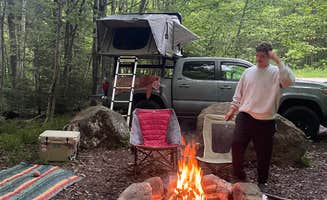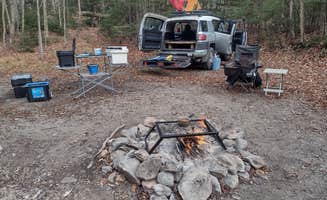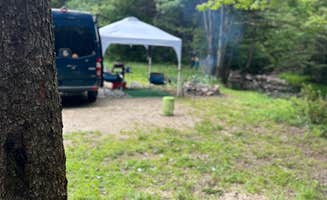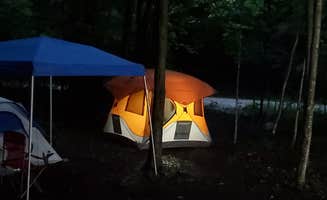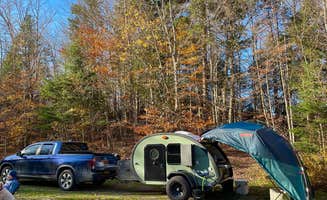Dispersed camping near Leverett, Massachusetts requires travelers to venture north into Vermont's Green Mountain National Forest. Most sites sit at elevations between 1,200-2,500 feet, where temperature swings of 30°F between day and night are common, especially in spring and fall. Waterproof gear is essential as many forest roads become impassable after heavy rain, with runoff creating seasonal streams through some established campsites.
What to do
Paddling at Somerset Reservoir: Located near Somerset Airfield, this large body of water offers excellent paddling opportunities. "The real attraction is the huge Somerset Reservoir which is up the road. Plenty of fishing, paddling, hiking and picnicking opportunities," notes a visitor who rated the experience 5 stars.
Hiking to mountain ponds: The area features several accessible hiking trails connecting to scenic mountain ponds. Near Statton Pond Camp on Forest Road 71, one camper mentioned, "Good hiking access to Stratton Pond, to Branch Pond, to Grout Pond Recreation Area, to the AT/LT." Trails range from easy 1-mile loops to challenging 8-mile treks.
Stargazing without light pollution: The remote locations make for excellent night sky viewing. A camper at NF83 Dispersed site 1 appreciated that it's "a great spot with no light pollution, cell signal or distractions." During summer months, the Perseid meteor shower (August) offers 60+ visible meteors per hour from these dark-sky locations.
What campers like
Separation between sites: Many campers appreciate the privacy at certain dispersed areas. At George D Aiken Wilderness Dispersed, a visitor noted, "The camp spots were all pretty spread out from each other and the road was easy to drive on. There were only about 10 spots along the access road."
Stream access: Several sites feature waterfront locations that campers specifically seek out. According to a camper at NF 83 - riverside, there's a "Peacefully placed along the bends of the river is a large open grassy area with a sizable fire pit!" These water-adjacent sites tend to fill first during summer weekends.
Local amenities within driving distance: Despite the remote setting, some visitors appreciate nearby towns. One George D Aiken camper mentioned, "Brewery, distillery, beautiful lakes and scenic towns all within 15 minutes of the sites." Most sites require 15-25 minutes driving on forest roads to reach paved highways and services.
What you should know
Road conditions vary dramatically: Many forest roads become challenging after rainfall. At NFR 273 Dispersed Camping Spot, a visitor reported: "Many pull offs but a lot were too wet for my van and I was afraid of getting stuck. The road itself was in great condition though."
Site availability depends on timing: Popular weekends can fill up surprisingly fast. One camper noted, "Went on a Wednesday night late October and had to drive about 4 miles down the dirt road to find a suitable spot." During summer holidays, arriving before Thursday afternoon is recommended.
Winter camping challenges: For cold-weather enthusiasts, preparation is essential. A winter camper at Somerset Airfield described: "We endured Snow and mid 20s Friday night with 8" of fresh snow to wake up to Saturday, and our main Roadhouse down from the weight of the snow. The stakes didn't hold in the frozen ground."
Sanitation concerns: Pack-in, pack-out principles aren't always followed. One camper at George D Aiken reported: "Site was littered with places previous campers had left human excrement. While not in the site directly, it was all around it." Bring a trowel and bury waste at least 200 feet from water sources.
Tips for camping with families
Site selection matters: For families, choosing the right site makes a huge difference. At Dispersed site along Forest RD 71, a return visitor shared: "I would have given 5 stars except for the unfortunate fact that 2 years in a row my husband and I had to spend over an hour cleaning the site from the people before us." Scouting multiple sites before settling in can save disappointment.
Consider insect protection: Dense forest sites have more bugs than open areas. One visitor noted at NFR 273: "A LOT of bugs due to dense wooded surroundings. The bugs seems to be unbothered by the bug spray as well." Sites in clearings with sun exposure and wind tend to have fewer insects.
Check for cell service: Emergency communication availability varies widely. At Statton Pond Camp, a camper reported "2 bars of USCellular LTE," while at Somerset Airfield another mentioned "AT&T service at bridge prior to camp - short walk. SOS only in camp." Download offline maps before arrival.
Tips from RVers
Vehicle clearance requirements: Some sites have specific requirements for vehicle ground clearance. One NF83 visitor warned, "Don't expect to get in here unless you have more than 8" of clearance under your vehicle." Even seemingly accessible roads can have washouts or rocky sections.
Multiple camping areas: The best RV sites often aren't the first ones you encounter. At Hogback Mtn Trailhead, a camper noted, "Great place to stop for the night. Not a lot of ambiance, but plenty of room for any number of rigs." Check for level parking areas with enough turning radius to exit safely.
Winter access considerations: Snow and ice create additional challenges. One Somerset Airfield camper explained: "In the winter be ready for snowmobiles, in the summer trucks." Many forest roads are not plowed and become snowmobile trails from December through March.


